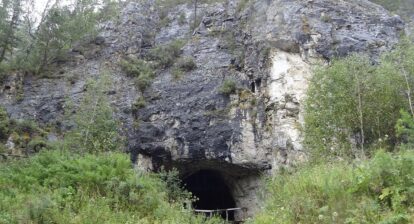This is definitely a first. Scientists have found hundreds of tiny, fossilized fecal pellets left behind 9 million years ago by scavenging worms as they devoured a Miocene fish’s brain and skull. The fossil poops or corpolites found hundreds of tiny, fossilized fecal pellets and the scientists say that they added up over time. The scavengers left behind enough pellets to fill up the brain case entirely. The fossil was found at Calvert Cliffs, a site in southern Maryland, which is home to fossils dating from about 18 million to 8 million years ago (the Miocene epoch), and the fish in question is the Astroscopus countermani, a type of bottom-dwelling ambush predator commonly known as a stargazer. This is the first time a fossil skull has been found, where the braincase is completely filled with poop! The small, oblong coprolite pellets that were found inside its head are known as Coprulus oblongus.

Scanning Electron Micrograph of a single fecal pellet white scale bar equals 1 millimetre. Image: Calvert Marine Museum

Fossilized Micro Corpolites probably left behind by worms inside a fish’s braincase. Image: Calvert Marine Museum
The scientists also examined other coprolite pellet deposits in the surrounding sediment or stuck to snails and barnacles and also found a 7 inches (18 centimeters) long corpolite that probably belonged to a crocodilian. Interestingly, there were tunnels threading through the poop that were probably left behind by other animals digging a home or eating the pellets.

These are the fossilized crocodile poop, broken open showing the burrows made by one or more kinds of poop-eating organism. The feeding gouge marks on the sides of the cylindrical burrows. (Image credit: Photo courtesy of the Calvert Marine Museum )
According to the study many fossils have been described from Calvert Cliffs fossils, including sharks and other fish, turtles, crocodiles, seabirds and seals. Many corpolites have also been collected from the site but they have been mainly from vetebrates. Invertebrate corpolites (such as these) have been rare.
Xray spectroscopy highlighted the high concentration of calcium in the pellets, signifying that they were indeed fecal matter. The scientists ruled out the numerous other scavengers that eat dead animal corpses, and suggest that from the size, shape and the fact that a soft bodied invertebrate would be the only thing to squeeze into the area, they have come to the conclusion that they poop was left behind by some sort of marine worms.
Full study DOI: https://doi.org/10.54103/2039-4942/17064





